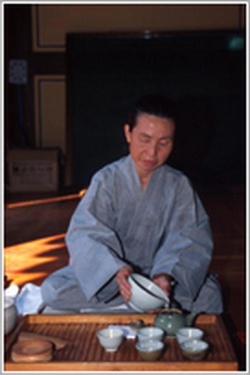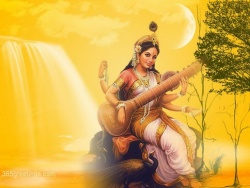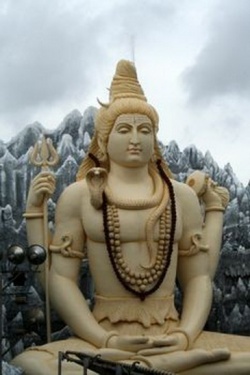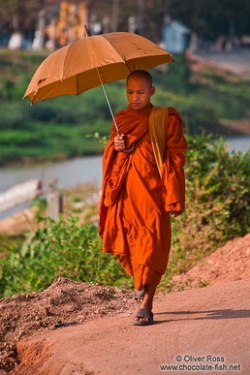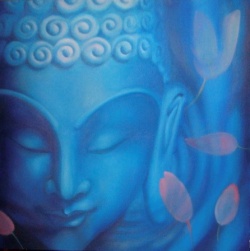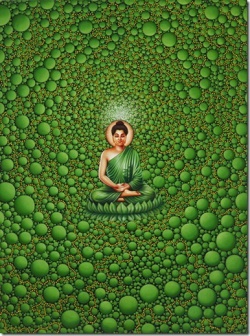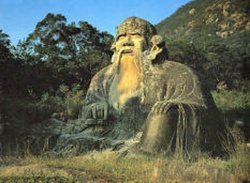Who Are the Rigdens?
Notes from a talk given, Thursday night, March 17, by Acharya David Schneider:
The Rigden
This word is being used more in our literature, liturgies and iconography.
Cannot understand, not accessible to divided, conceptual mind – “Rigden don’t live there.”
To talk about it, it is necessary to relax your mind. Loosen your grip on your version of reality…will come closer to actual reality…this is more like poetry than anthropology.
“rig” means ‘clan’ or ‘lineage.’
“den” means ‘having,’ ‘holding,’ ‘possessing.’
Together it means: “the holders of the family lineage or clan.”
David begins telling a story:
The Kings of Shambhala:
The first King of Shambhala – Suchandra (Tibetan = Dazampa, “good moon.”)
The historical Buddha, Shakyamuni, taught the king of Shambhala, Suchandra, and initiated him – “monks out!” the Buddha said. This was a teaching for lay-people.
This teaching was the Kalachakra Tantra – the pinnacle of the Vajrayana – there is no higher tantra. Suchandra took the tantra teaching back with him to his kingdom (Shambhala) and made it the state religion there.
This is responsible for why we cannot see Shambhala anymore. Some say it ascended entirely, some say it’s still there.
[The synchronicity between the term Sanskrit term Rigden and the Mormon name Rigden, the parallel ideas of Shambhala, Zion, and the City of Enoch, and the similarities between termas, tertons, Joseph Smith and the Book of Mormon are phenomenal and serendipitous, to say the least.]
This is not the only religion in Shambhala
[Again a very familiar Mormon idea in terms of the future Zion utopia and freedom of religion, conscience, and expression.]
Seven kings later there was strife. Some didn’t want to do it anymore and bailed. It wasn’t easy to leave.
The seventh King was Manjushri Yashas. He used magical persuasion and brought them back. He was called the first Rigden because he held the clan through commitment and dedication? devotion? to teachings.
Before this kings were referred to as “Dharma Raja”. After that, “Rigdens.” There were 7 Dharma Rajas and 25 Rigdens. We are under the reign of the 21st or 22nd Rigden.
There is a prophecy that during the reign of the 25th, things get so bad that they come out of Shambhala and “clean things up”!
They pay close attention to the human realm and are very affected by it and care very deeply. The Rigden during WWII died of a broken heart!
Trungpa Rinpoche talks about the Rigden fathers. There’s another meaning before that level (the kings above). The before level is the basis of Shambhala, together the whole lineage An absolute or ultimate level.
A chant – the homage
He who is neither beginning or end.
Possesses confidence beyond words.
I pay homage to the Rigden King….
[[[Wikipedia:sounds|sounds]] like Melchizedek]
Part of the standard liturgy now….
“May the goodness of the Rigden King be present.”
This Rigden king is not one exactly, it’s a “Rigden principle,” or absolute or primordial Rigden. An absolute level of being indivisible from the relative way of being. We’re so busy with relative that we forget – can’t feel the absolute way of being – the basis of Shambhala, where we came from.
What is it that has no beginning or ending in Tibetan [no he?] referring to a level of being/mind before thought/concept. It’s happening all the time – in between thoughts “gap out.”
The Rigdens are the inhabitants of the Cosmic Mirror.
Before concept, primordial mind, what’s there when you let go of thoughts. It’s not possible to stop thinking – it is possible to notice thoughts and gaps between thoughts. It’s a source of character development to let go of thoughts – that’s relaxing. You can let go of any thoughts. There’s a space like an “ah” or other seed syllables. There’s an unbounded, limitless space out of which things spring all the time. This is the abode of the Rigden. This space is rich and pregnant and fertile, possessing the glory of the tiger, lion, garuda, dragon, “the five dignities.” It’s glorious with specific colors, qualitites, and power. Applicable in daily life. There is no shortcut to glory. Rigden is in charge. You have to go through him to get the glory.
Spacious
Open
Unbounded
Glorious
Colored
Powerful
And confidence beyond words – doesn’t need anything – it’s basic goodness – it’s before any reason to be good.
David tells a wonderful story about his 2 ½ year-old daughter. She asks “why” about everything. So he decided to turn the tables on her and asks her “why” about everything. Her answer to “why” (she’s German) is “just so.”
Letting it in: it’s right there outside the door - glorious power, wisdom, fireworks, ice cubes, everything – whatever you want. We can’t lose it but we can ignore it.
Rigden is about opening up to that – relaxing. That’s the absolute, somewhat un-manifest level.
Q: Why would you address it, give it a name or rank it like a king?
A: In ‘relative’ you could say ‘Queen,” in absolute you’d say ‘ruler.’
It’s this space that’s giving rise to everything in our life. It’s your ruler principle, it allows you to rule.
Who’s the boss? In sitting meditation you are the boss.
Manifest – kings or rulers of Shambhala.
A tip or insight into visualization
Q: Does the Rigden exist?
A: The Rigden principle is like a strong emotion that exists in you, like hate. It has color and is so strong could be made into sculpture. You could kick it or worship it, sometimes our emotions are that tangible. You might see Rigden as a person that emanates for your own conviction. On the one hand they don’t exist, on the other hand they do.
Rulership – ruling your own life.
Sakyong = “earth protector,” like Rigden, but an earthly manifestation. One who has trained in these techniques of relaxing and opening.
It comes down to embodying that, becoming Rigdens.
The primary way of our training, meditation. Not the only way but extremely helpful. Slowed down. Sit. Can begin to notice gaps and power of the mind even when nothing is happening.
Other techniques, opening to your sense perceptions and regarding them as sacred.
Entrance into the Rigden principle.
Not just a glass of water but being “stunned by your perceptions.”
The act of perceiving without blending your perceptions together and naming it – a chair.
Let that open you up instead of just closing that down.
The moon and the weather and the elements are good for this.
We are sensual beings. In monk training you put a clamp on your senses. Whereas on the path of Shambhala warriorship and rulership we use the senses in a different way. No need to fear, can be used for enlightenment, not to be stupid or indulgent, but really living there/senses in a sacred world.
There’s a profound meaning…our Shambhala Buddhist path. Our asst. is that we should not separate religion and secular life. Our aim is that they’re completely integrated. Your spiritual life is meant to deepen your secular, your secular life is meant to deepen your spiritual – no gap.
The way you do the things you do counts in Shambhala.
The Arhat is the hero of Hinayana. The Bodhisattva of the Mahayana, or tantric yoga. Here it is the Rigden King or Queen [Another Mormon parallel].
Open to infinity or depth of sense perceptions. Different emphasis.
Points to social engagement, community, culture.
Q: Why do we close the blinds?
A: Fear of the unknown. It’s a bad habit. We get comfortable in our routines and silly limiting routines. We’re afraid if we let go of those, something uncomfortable could happen. Fear of loss of reference point (normally our reference points drive us nuts.) When we let go we get glory back and it’s not personal and we don’t have to organize it. Whatever phenomena are taking place you know how to ride them.
The power, not your personal power. It’s already there. Let go of self and it’s accessible. Bodhisattva acquires siddhis powers but only for the benefit of others.
Before beginning or ending. Not the same as eternal. Something before the concept even of beginning or ending. Something before the concept of the teaching.
Q: Is the Rigden place a place where questioning is not necessary?
A: An important topic, an important talk.
Q: Tell us the why and the how of our new thangka?
A: The Sakyong’s job is to shape and guide Shambhala on earth. What he’s doing is to point out the things that bind Shambhala Buddhist teachings. Shaping and binding and holding the family…IS this Ridgen principle. He’s going back to the things that his father had begun. In all contemplative or religious traditions absolute_______by word or concept, always some teachings of absolute state, ways to describe it, draw it out (infiltrate?) concretely manifest reality.
Your life is a spectrum.
Q: What if a little Rigden principle comes in?
A: Relax more.
Q: Senses – the role of art and beauty.
A: The artist is integrated into the Shambhala vision.
Humans are dignified, worthy, deserve to celebrate their lives. Beauty, elegance, dignity are not outside us, they are our potential. An artist can call that forth for themselves and others.
Trungpa Rinpoche – “we don’t have any art, we do everything the best we can.” It’s not special, just an extension of our daily lives.
The wind and the water – it’s natural, you’d write a poem about it, but it’s no different than the way you’d put away the forks.

